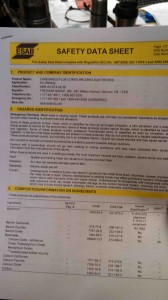Reviewing a material safety data sheet (MSDS), or soon to be called a SDS (safety data sheet), can be a useful skill. Most times the product is straightforward and gives you what you need. However, there are somethings to watch for and areas to focus to make your reviewing skills better.
To start, Â make sure you have the right SDS. Match the product with the form. If is is not exactly right, find the right one. It must list the model/product name & manufacturer.
- What is the date of the SDS?
- is it the most recent?
- when was it last updated?
- Look at section 2/3 (Hazardous components) VERY carefully.
- google the CAS# and find the name (they sometimes hide the true-name)
- look at the % of each component
- what is the listed exposure limit? Is it correct? What about other recommended limits?
- remember the hazard is only listed in this area if it is greater than 1% of the total
- Look through each section mindful of how you will be using the product.
- for example: if you are going to be burning the product, usually the SDS will not address these types of concerns/exposures
- what are the required PPE during “regular use”
- what happens if you use this product in a confined area?
- does the manufacturer recommend air monitoring? when?
- Familiarize yourself with the emergency procedures
- what if it spills?
- disposal?
- what can cause exposure? inhalation? skin?
- Look at the other sections with a inquisitive eye
- do they list other chemicals, which are NOT included in the product section? why?
- do they mention Proposition 65?
- Finally,
- post/make available a copy wherever it’s needed
- make sure you know the product
It is a mixed-bag when it comes to the quality of SDS from a manufacturer. Some of them will work with you, others are a total-pain. Remember it is YOUR RIGHT to know about the products you use. If you don’t feel comfortable with the information they’ve given you, call them. OR, go find another product.
